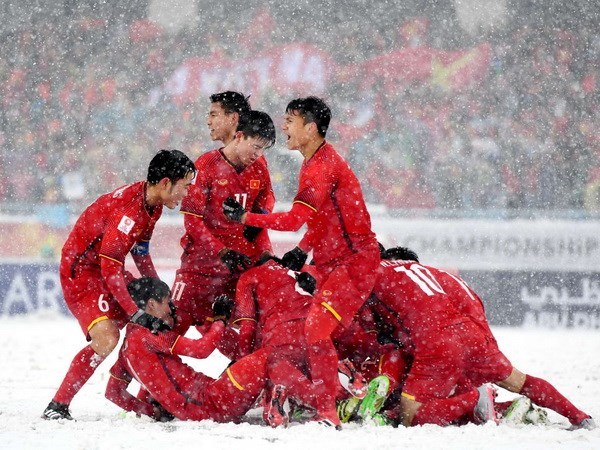[ad_1]
After the penalty shootout against Qatar in the 2018 Asian Football Confederation (AFC) Under 23 Championship semi-final match that carried Vietnam into the final of the competition for the first time in history, thousands of fans flocked to the streets nationwide to celebrate.

Vietnam U23 captain Luong Xuan Truong (right) competes in the final of the Asian Football Confederation U23 Championship in Changzhou, China, on January 27.
It was a historic moment for Vietnamese football and it’s a good time to recall the beginning of a journey that began twenty years ago.
The scene of thousands of supporters waving golden starred flags was reminiscent of the crowd that painted the streets of Hanoi red on the night of September 3, 1998. Vietnam pulled off a 3-0 shock victory against Thailand in the semi-final game of the Tiger Cup (the former Southeast Asia football championship).
Before that night, Vietnam had never managed to beat Thailand, the region’s heavyweight and reigning champion with a generation of players who later went on to compete in the final stage of World Cup qualifying for Asia in 2001.
This unexpected victory produced something unprecedented for Vietnamese football: a confidence in the ability of Vietnamese players to play any team in the region and win. Many were optimistic. In fact, so optimistic that they claimed the golden age of Vietnamese football was here.
But reality bit hard. Vietnam lost to Singapore a few days later in the final, an opponent considered much weaker than Thailand. Most players in that Vietnam squad were in their late twenties and thirties. Most struggled to maintain top form in the years to come with a few even retiring several years later.
The promised golden age, would have to wait.
Nevertheless, the newfound confidence spurred the country into action. National squads received more support, foreign coaches were hired, and youth football training and talent scouting were intensified. It was perhaps the first time a long-term plan to develop Vietnamese football was formulated and implemented.
During those years, there were numerous clashes against the Thais, Vietnam’s regional archrival, among other strong opponents.
Results were mixed, which part of the game but the 1998 semi-final game allowed Vietnamese players to play with confidence, knowing they could win.
Vietnamese fans would have to wait another ten years to see their team lift silverware. Vietnam faced the Thais in the 2008 AFF Suzuki Cup in the home-leg final at My Dinh Stadium in Hanoi on December 28. This time, the team brought home the cup with a 3-2 aggregate win.
Compared to their predecessors, the 2008 squad consisted of younger players, who were playing in a far more professional and competitive domestic league. They also enjoyed better training equipment, more frequent overseas trips and the services of physical therapists and nutritionists.
It took 10 years to produce a generation of players that brought home silverware. It was a long journey, one that the fruits of its labour were, at times, difficult to see. The moment striker Le Cong Vinh, who scored the goal to win the country’s first regional football title, lifted the trophy at the My DinhStadium was the fruits of those ten years of labour.
Another ten years passed. Last week, the young players of U23 Vietnam reached the AFC Championship final, an unprecedented achievement for any team from Southeast Asia.
U23 Vietnam players returned on January 28 with much fanfare, which was nothing more than they deserved. Despite losing the final with seconds left on the clock in extra time, they put on a show, arguably one of the best demonstrations of tenacity and willingness to play with all they have in the nation’s football history.
Many of them first gathered in 2007 at a football academy in the Central Highlands province of Gia Lai: the Hoang Anh Gia Lai – JMG Football Academy, the first of its kind in Vietnam.
They were a generation of talented youngsters (most were born just two, three years prior to the Tiger Cup semi-final of 1998), who for the next ten years would endure rigorous training under the guidance of professional coaches with the support of state-of-the-art training facilities.
Many of them now make up the backbone of U23 Vietnam including Cong Phuong, Xuan Truong, Van Thanh, Hong Duy and Van Toan, and with little doubt they will fill out the national football squad soon. Other members of the team are also young players who were discovered at an early age.
From 2007 to now, it has taken 11 years to produce another generation of excellent players, one that is tasked to carry the torch, to make their motherland proud and to strive for the top.
In the craze of U23 Vietnam’s success, companies and brands wasted little time to shower the young players with gifts and bonuses. Millions of dollars worth of prizes have been promised to individual players and the team as a whole.
Just like any football craze before it, this too shall come to an end and when it does it is of crucial importance for Vietnamese footballers and fans to see U23 Vietnam’s achievement at the AFC Championship for what it is: a result of long-term investments and foresight in the nation’s strategy to develop football, not just a moment of brilliance.
If one is to see the result delivered by U23 Vietnam today as a logical conclusion of such investments and foresight then the only possible way to reproduce such a result is to continue with long-term investments in sports development.
This is a particularly pressing matter as many Vietnamese schools, especially in big cities, don’t have the facilities to support a robust sports culture and develop young talents.
Such investments may be what is needed for talented youngsters to start their journeys in the pursuit of their dreams, much like the U23 players today.-VNA
[ad_2]
Source link
